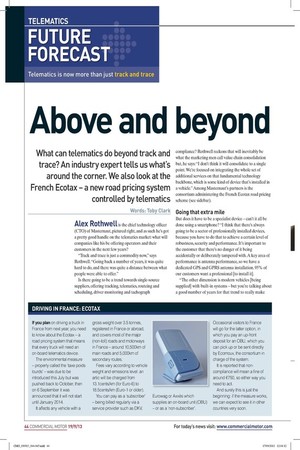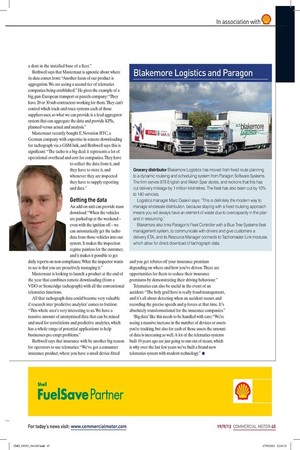Above and beyond
Page 35

Page 36

If you've noticed an error in this article please click here to report it so we can fix it.
What can telematics do beyond track and trace? An industry expert tells us what's around the corner. We also look at the French Ecotax a new road pricing system controlled by telematics Words: Toby Clark
Alex Rot hwell is the chief technology officer (CTO) of Masternaut, pictured right, and as such he's got a pretty good handle on the telematics market: what will companies like his be offering operators and their customers in the next few years?
"Track and trace is just a commodity now," says Rothwell. "Going back a number of years, it was quite hard to do, and there was quite a distance between what people were able to offer." Is there going to be a trend towards single-source suppliers, offering tracking, telematics, routeing and scheduling, driver monitoring and tachograph
compliance? Rothwell reckons that will inevitably be what the marketing men call value chain consolidation but, he says: "I don't think it will consolidate to a single point. We're focused on integrating the whole set of additional services on that fundamental technology backbone, which is some kind of device that's installed in a vehicle." Among Masternaut's partners is the consortium administering the French Ecotax road pricing scheme (see sidebar).
Going that extra mile
But does it have to be a specialist device — can't it all be done using a smartphone? "I think that there's always going to be a sector of professionally installed devices, because you have to do that to achieve a certain level of robustness, security and performance. It's important to the customer that there's no danger of it being accidentally or deliberately tampered with. A key area of performance is antenna performance, so we have a dedicated GPS and GPRS antenna installation. 95% of our customers want a professional [to install it]. "The other dimension is modern vehicles [being supplied] with built-in systems — but you're talking about a good number of years for that trend to really make
a dent in the installed base of a fleet."
Rothwell says that Mastemaut is agnostic about where its data comes from: "Another focus of our product is aggregation. We are seeing a second tier of telematics companies being established." He gives the example of a big, pan-European transport or parcels company: "They have 20 or 30 sub-contractors working for them. They can't control which track-and-trace systems each of those suppliers uses, so what we can provide is a feed aggregator system that can aggregate the data and provide KPIs, planned versus actual and analysis." Masternaut recently bought E.Novation BTC, a German company with expertise in remote downloading for tachograph via a GSM link, and Rothwell says this is significant: "The tacho is a big deal: it represents a lot of operational overhead and cost for companies. They have
to collect the data from it, and they have to store it, and whenever they are inspected they have to supply reporting and data."
Getting the data
An add-on unit can provide mass download: "When the vehicles are parked up at the weekend — even with the ignition off — we can automatically get the tacho data from those vehicles into our system It makes the inspection regime painless for the customer, and it makes it possible to get
daily reports on non-compliance. What the inspector wants to see is that you are proactively managing it."
Masternaut is looking to launch a product at the end of the year that combines remote downloading (from a VDO or Stoneridge tachograph) with all the conventional telematics functions.
All that tachograph data could become very valuable if research into 'predictive analytics' comes to fruition: "This whole area's very interesting to us. We have a massive amount of anonymised data that can be mined and used for correlations and predictive analytics, which has a whole range of potential applications to help businesses pre-empt problems." Rothwell says that insurance with be another big reason for operators to use telematics: "We've got a consumer insurance product, where you have a small device fitted
and you get rebates off your insurance premium depending on where and how you've driven. There are opportunities for fleets to reduce their insurance premiums by demonstrating their driving behaviour."
Telematics can also be useful in the event of an accident: "The holy grail here is really fraud management, and it's all about detecting when an accident occurs and recording the precise speeds and g-forces at that time. It's absolutely transformational for the insurance companies." 'Big data' like this needs to be handled with care: "We're seeing a massive increase in the number of devices or assets you're tracking, but also for each of those assets the amount of data is increasing as well. A lot of the telematics systems built 10 years ago are just going to run out of steam, which is why over the last few years we've built a brand-new telematics system with modem technology." •







































